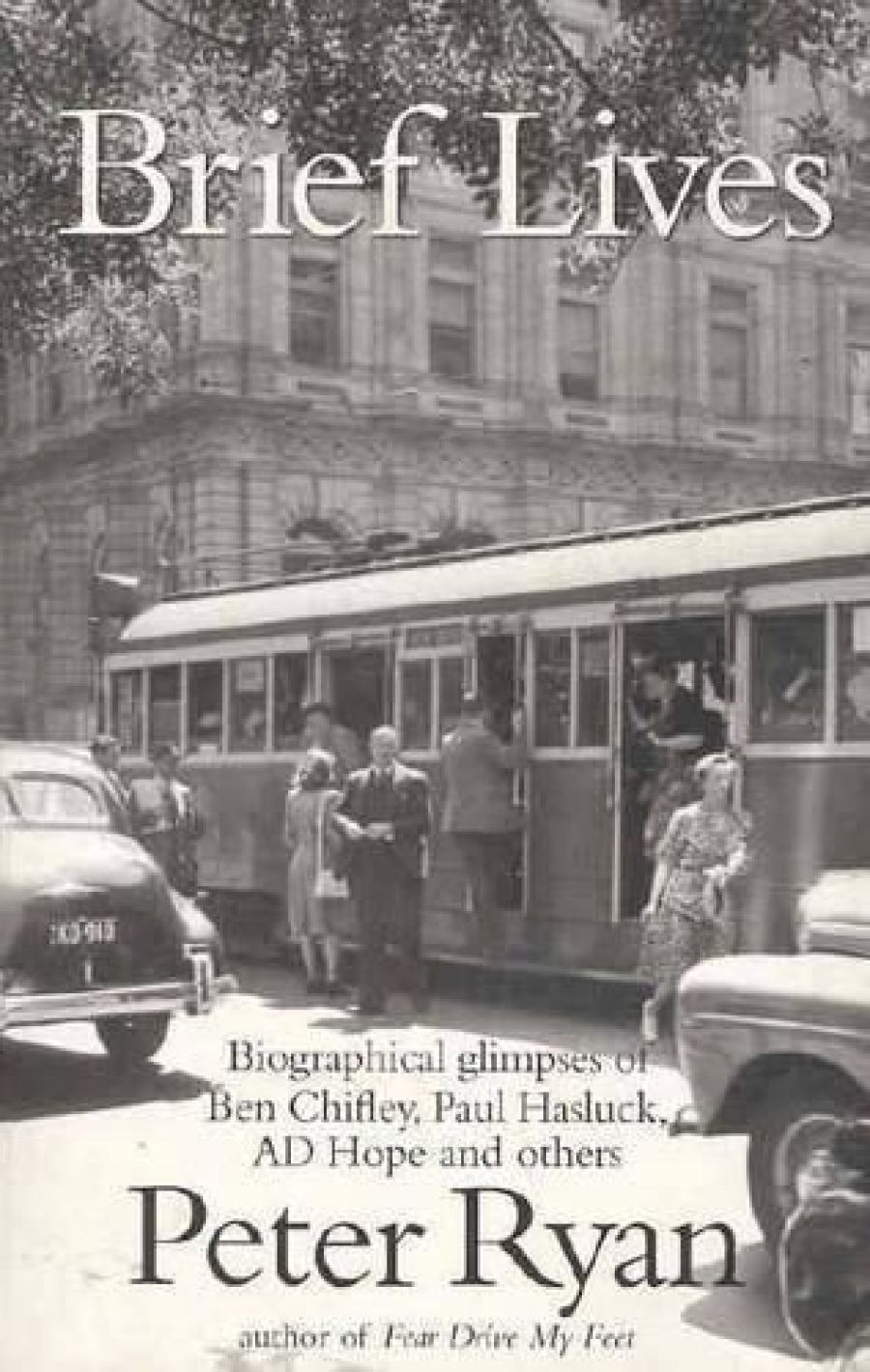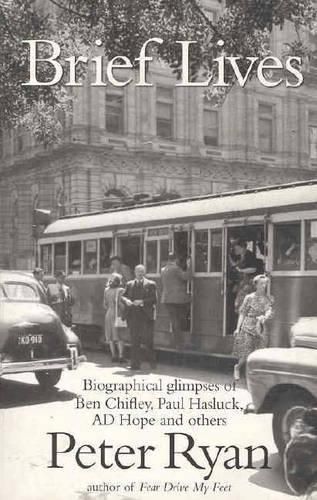
- Free Article: No
- Contents Category: Biography
- Review Article: Yes
- Article Title: Quirks and Crotchets
- Online Only: No
- Custom Highlight Text:
In a long and interesting life, Peter Ryan has been especially fortunate in getting to know quite a few influential Australians and some little-known but unforgettable characters. Brief Lives offers pen portraits of fifteen of them, all but one of them male. The solitary female, Ida Leeson, had the distinction of being the ‘presiding genius of the world-famous Mitchell Library’, held the rank of army major in World War II, and was perhaps regarded as an honorary male in the Directorate of Research and Civil Affairs (DORCA), a rather peculiar army unit where Ryan met her in 1944.
- Book 1 Title: Brief Lives
- Book 1 Biblio: Duffy & Snellgrove, $22pb, 185pp
- Book 1 Cover Small (400 x 600):

- Book 1 Cover (800 x 1200):

This slim volume (one of the last titles published by Duffy & Snellgrove) would be an invaluable aid should anyone ever propose writing a life of Ryan, for his subjects often represent personal milestones of one kind or another, or reveal how his career flourished through his uncanny ability to be in the right place at the right time. A ‘million-to-one-chance lunchtime encounter in Melbourne’s Collins Street’ with a senior New Guinea district officer, who had been his boss for a time, led to an interview with Alf Conlon and to Ryan’s attachment to DORCA. Conlon, not only the head but the creator of DORCA, seems to have been a power-broker, a go-getter and an influential intermediary between Prime Minister John Curtin and his commander-in-chief General Blamey. Conlon personally selected his staff, which contained more than a few notables, such as John Kerr, the future governor-general; James McAuley and Harold Stewart (who were inventing the famous literary hoax ‘Ern Malley’ at a desk nearby); and some embryonic professors, including the geographer John Andrews, the historian John Legge and the famous medical professor ‘Panzee’ Wright. It seems that the 21-year-old Ryan was taken into DORCA because Conlon desperately needed some staff members who had seen the light of battle. He knew that Ryan had been recommended for the Military Medal ‘and was soon to be Mentioned in Despatches’. Ryan was given no choice. Then, in the late 1950s, Ryan was out of a job and his old friend Creighton Burns made to Macmahon Ball, then chairman of the Melbourne University Press Board, ‘the hair-raisingly risky proposal that [Ryan] be considered for the post of Director of MUP’, with the result that Ryan enjoyed ‘twenty-six years in Heaven as a publisher’.
These biographical glimpses vary widely in length, the briefest, that of the heroic army doctor ‘Blue’ Steward, taking no more than four pages, and the longest, dealing with the eccentric polymath Alf Conlon, thirty-four pages. In part this may be due to the influence of Conlon and DORCA on Ryan’s life, but it seems more likely that the space allows Ryan to canvas Conlon’s importance in Australia’s history. Among his many other achievements, Conlon established the School of Civil Affairs in Canberra, and with ‘Panzee’ Wright ‘over a few bottles of claret produced a document which was the first item on the file for the eventual Australian National University’. Ryan is less fulsome but equally admiring of the disparate characters he has chosen to commemorate. They cover the spectrum from governor-general to a doorman at the Florentino, a famous Melbourne restaurant.
Some pieces have been written for this collection; others, previously published in journals or newspapers, ‘have been thoroughly revised for this book’. This may account for a sense of strain that sometimes underpins Ryan’s style. A reckless clutter of alliteratives lacks the ‘sense, tact and firmness’ with which Allan Fleming, director of the National Library of Australia, quells a committee of bigshots whose meetings are marred by ‘undertows of arrogance, surging seas of self-importance, cross-currents of crankiness’. Likewise, Ryan’s description of the political scientist Macmahon Ball: ‘though he never affected fashionable modernity of attire, he was vain about his appearance, understood very well that his presence was imposing.’ One wishes for the spare simplicity of Ryan’s much-admired Fear Drive My Feet (1959).
Peter Ryan aims to record, in this mixed bag of pithy encomiums, ‘the traits, the quirks, the crotchets which make them all distinctive, and made them lovable’. Yet, in dealing with some he has loved, he manages to take a few swipes at those he clearly dislikes. In his article on Conlon, General Blamey is referred to as a ‘notorious loose-liver’ and a man whose life was ‘crammed with acts of spite and folly’. Writing on Leeson, Ryan includes a Manning Clark anecdote in which Clark acknowledges his debt to her, then ‘spoils a gracious compliment by sniggering at her old-fashioned bloomers secured by elastic below the knee and clearly visible as she ascended ladders in the Library’. Thus Ryan spoils a gracious biographical glimpse with an unlovely and unnecessary snippet about his subject, and a snide crack at a man who brought much kudos (and profit?) to Ryan’s Melbourne University Press.


Comments powered by CComment